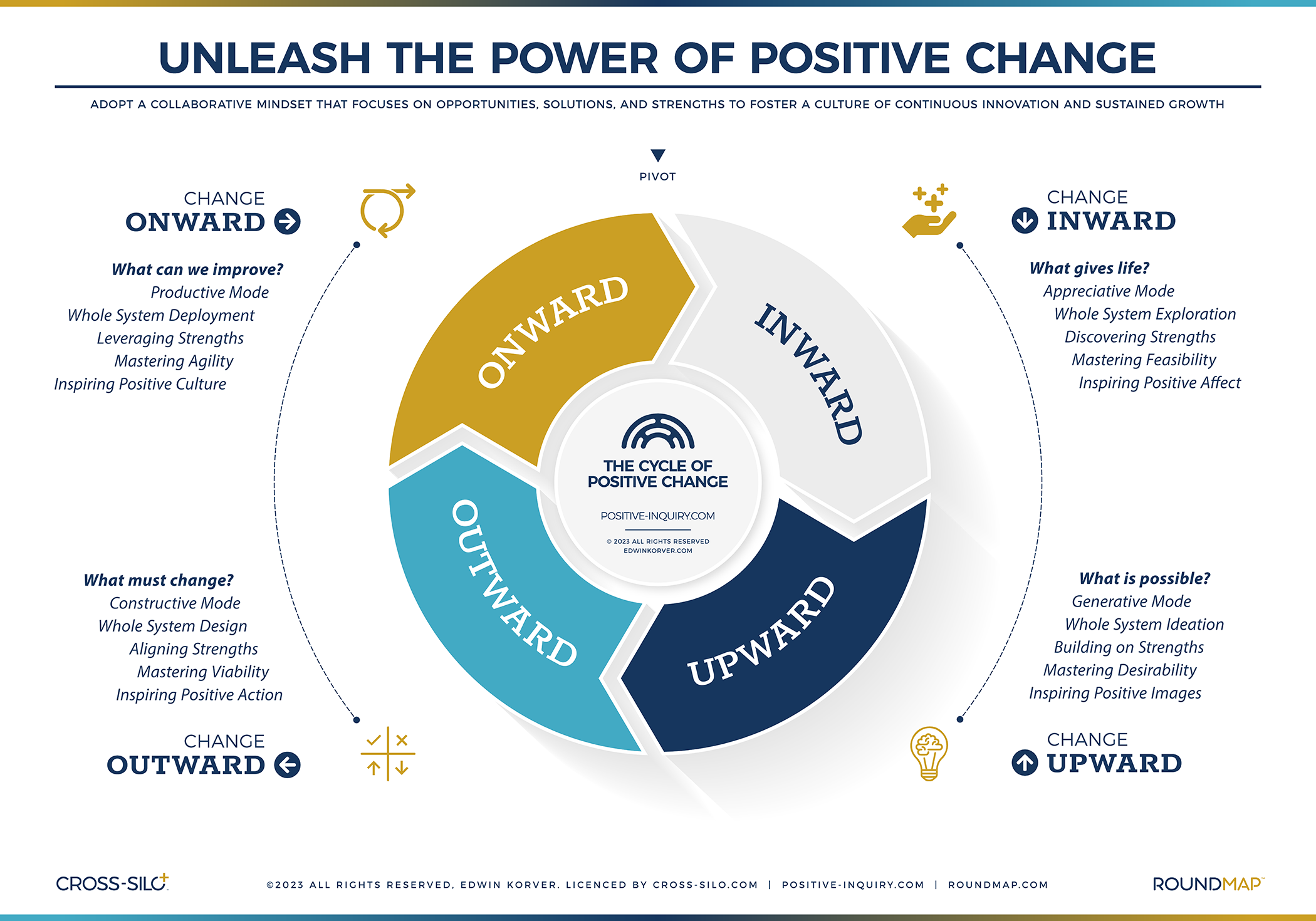The Positive Inquiry™ Cycle (PI Cycle) is a framework used in organizational development and change management. It provides a structured process for engaging the whole human system in a positive and strengths-based approach to change, focusing on what already works well within an organization. It encourages active participation, collaboration, and a sense of ownership throughout the change process by engaging vested stakeholders in discovering strengths, envisioning possibilities, designing actions, and delivering results.
The PI Cycle is part of RoundMap™, a cutting-edge organizational development and change framework. RoundMap™ comes from years of study to uncover the root causes of siloization and alienation. These factors notoriously hamper a firm’s capacity to adapt and innovate quickly and effectively.
The PI Cycle is successfully deployed at Fortune 500 companies in cooperation with KERN, an Omnicom Group agency, and the founders of positive change, Prof. David Cooperrider and Prof. Ronald Fry.
PI Cycle Outcomes
The PI Cycle method leads to a collective generation of feasible, desirable, viable, and sustainable pathways toward the future. The method will help your firm plan better, respond faster, and innovate more effectively. It will allow your firm to adapt more quickly, capitalize on, and thrive in a climate of rapid change.
PI Cycle Method
The PI Cycle method leads to a shared understanding of the organization’s core strengths, values, and beliefs. With renewed hope, the method lifts the organization to higher ground by imagining what could and should be possible. The teams will co-develop innovations, test their viability, and implement those most likely to lead to sustained growth.
The PI Cycle in four straightforward steps:
- CHANGE INWARD | Exploring feasibility: Reflecting on the root causes of past and present success.
- CHANGE UPWARD | Exploring desirability: Imagine and co-design what is possible.
- CHANGE OUTWARD | Exploring viability: Validate the propositions and identify the required changes.
- CHANGE ONWARD | Exploring sustainability: Implement the change to deliver the generated value.
Whole System
The whole system has two meanings: (1) it incorporates vested stakeholders, including leadership, management, employees, strategic partners, suppliers, and customers. And (2) it considers the organization as a whole, an integrated entity defined and limited by the interactions between its parts.
Transformational change points to the emergence of an entirely new state prompted by a shift to what is considered possible or necessary. This could result in a profoundly different structure, culture, or level of performance. This is bound to affect every silo and tier in the organization. Therefore, everyone’s voice should be heard. Transformative change is neither top-down, bottom-up, nor middle-out, it emerges from the whole.
Research by McKinsey on what made companies survive the recession caused by the 1973 oil crisis provides some answers to how your company can emerge from crises victoriously. However, 50 years ago, the speed of change was much slower, and the competition wasn’t as global. Digital wasn’t even on our radar, and the desire to find meaning in work was hardly an issue.
In hindsight, the best-run companies, described in the best-seller In Search of Excellence, were inventing agile innovation. However, the ruling notion in the business community was that continuity had to be defended at all costs. Disruptors, people with fresh ideas about new business opportunities, needed to be contained. Consequently, these ideas had to be developed in stealth mode ─ hidden from leadership and the rest of the company.
Given our current conditions, the shift firms must make is much more complex. Yet, no one in the organization is smart enough to oversee the whole operation. But together, you can. And must, if you plan to make it past the disruptions.
Combining our whole system approach with an agile innovation mode offers the best of both worlds. Instead of turning a blind eye to innovation, Positive Inquiry aims to harness the generative capacity of the entire organization. Bringing forth the most viable innovations for everyone to see, enjoy, and support. And doing so at the highest speed possible.
Change Cycle
Today’s precarious economic, geopolitical, and market conditions demand a fast and practical approach to organizational development and change. We knew these conditions would return as they are long-cyclical. Firms can overcome most challenges by applying the learnings from past recessions combined with Positive Inquiry.
Besides, coming from an industrial age with a focus on long-term shareholder value, we tend to see progress as linear because of the length of the lifecycle. This false notion of undisrupted continuation may lead to complacency, causing signs of impending disruption to be overlooked or ignored.
Today, lifecycles are much shorter due to the ever-increasing speed of change. Quick learning cycles need to feed the 4C Cycle for practical improvements, rapid adaptation, continuous innovation, or transformative change.
Research
Research by Gartner in 2022 revealed that employees’ willingness to support enterprise change collapsed to just 43% in 2022, compared to 75% in 2016. Remarkably, 75% of organizations adopt a top-down approach to change. Leaders set the change strategy, create detailed implementation roadmaps, and deploy a high volume of change communications. Given these numbers, is it surprising that 70% of business transformations fail?
Furthermore, according to Microsoft’s Work Trend Index ─ a global survey of workers across multiple industries and companies, published in September 2022 ─ more than half of managers (53%) report feeling burned out at work. How much more can managers bear?
McKinsey’s Liz Hilton Segel: “The world is different. As a CEO right now, your job is all about prioritization. The first to consider is building resilience as an organizational muscle. The second is a courageous mindset toward change — leaning into change instead of moving away from it. Next, technology, which should be considered the foundation for growth. The focus on technology relates to building new businesses and taking advantage of other shifts, like the energy transition. CEOs should not take their foot off the gas on net zero and should continue the progress we see across industries.”

